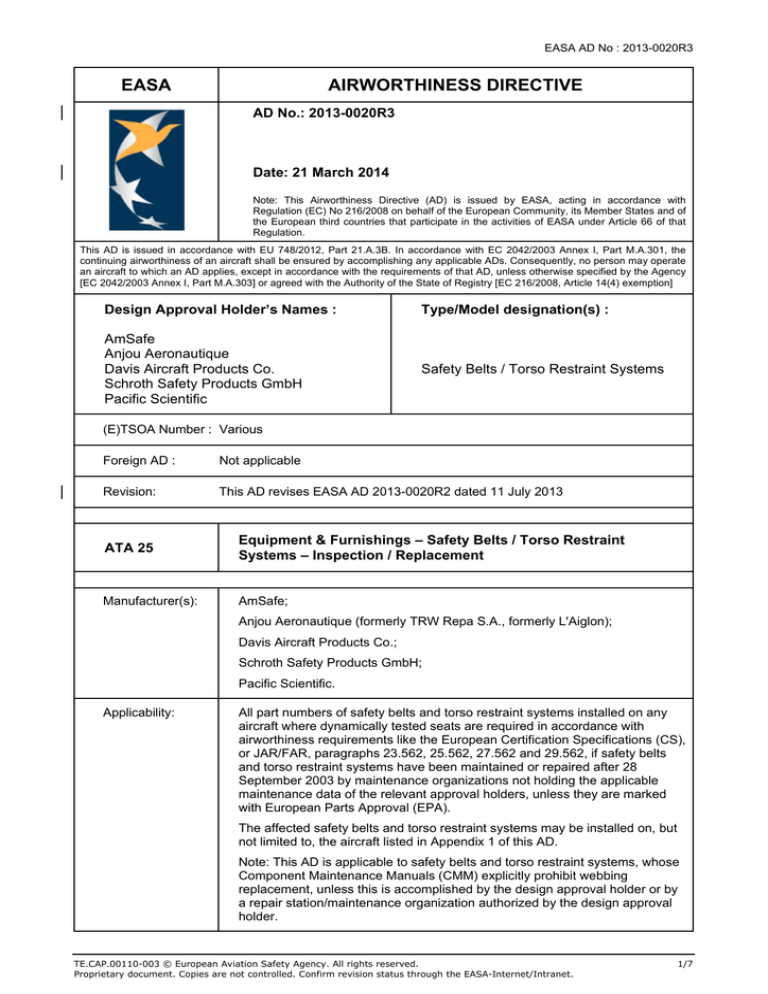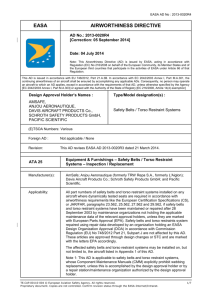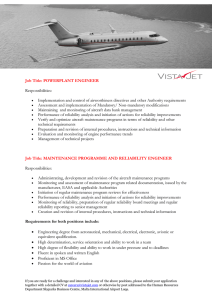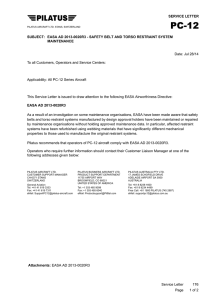
EASA AD No : 2013-0020R3
EASA
AIRWORTHINESS DIRECTIVE
AD No.: 2013-0020R3
Date: 21 March 2014
Note: This Airworthiness Directive (AD) is issued by EASA, acting in accordance with
Regulation (EC) No 216/2008 on behalf of the European Community, its Member States and of
the European third countries that participate in the activities of EASA under Article 66 of that
Regulation.
This AD is issued in accordance with EU 748/2012, Part 21.A.3B. In accordance with EC 2042/2003 Annex I, Part M.A.301, the
continuing airworthiness of an aircraft shall be ensured by accomplishing any applicable ADs. Consequently, no person may operate
an aircraft to which an AD applies, except in accordance with the requirements of that AD, unless otherwise specified by the Agency
[EC 2042/2003 Annex I, Part M.A.303] or agreed with the Authority of the State of Registry [EC 216/2008, Article 14(4) exemption]
Design Approval Holder’s Names :
Type/Model designation(s) :
AmSafe
Anjou Aeronautique
Davis Aircraft Products Co.
Schroth Safety Products GmbH
Pacific Scientific
Safety Belts / Torso Restraint Systems
(E)TSOA Number : Various
Foreign AD :
Not applicable
Revision:
This AD revises EASA AD 2013-0020R2 dated 11 July 2013
ATA 25
Equipment & Furnishings – Safety Belts / Torso Restraint
Systems – Inspection / Replacement
Manufacturer(s):
AmSafe;
Anjou Aeronautique (formerly TRW Repa S.A., formerly L'Aiglon);
Davis Aircraft Products Co.;
Schroth Safety Products GmbH;
Pacific Scientific.
Applicability:
All part numbers of safety belts and torso restraint systems installed on any
aircraft where dynamically tested seats are required in accordance with
airworthiness requirements like the European Certification Specifications (CS),
or JAR/FAR, paragraphs 23.562, 25.562, 27.562 and 29.562, if safety belts
and torso restraint systems have been maintained or repaired after 28
September 2003 by maintenance organizations not holding the applicable
maintenance data of the relevant approval holders, unless they are marked
with European Parts Approval (EPA).
The affected safety belts and torso restraint systems may be installed on, but
not limited to, the aircraft listed in Appendix 1 of this AD.
Note: This AD is applicable to safety belts and torso restraint systems, whose
Component Maintenance Manuals (CMM) explicitly prohibit webbing
replacement, unless this is accomplished by the design approval holder or by
a repair station/maintenance organization authorized by the design approval
holder.
TE.CAP.00110-003 © European Aviation Safety Agency. All rights reserved.
Proprietary document. Copies are not controlled. Confirm revision status through the EASA-Internet/Intranet.
1/7
EASA AD No : 2013-0020R3
Reason:
As a result of an investigation on some maintenance organisations, EASA was
made aware that safety belts and torso restraint systems manufactured by
design approval holders have been maintained or repaired by maintenance
organisations without holding approved maintenance data.
In particular, the affected restraint systems have been refurbished using
webbing materials having mechanical properties significantly different with
respect to the materials used to manufacture the original restraint systems
(e.g. nylon instead of polyester).
Based on tests performed in the frame of an EASA approved STC
(refurbishment of seat belts on dynamically tested seats in compliance with
CS 25.562) and during a research project on safety belt performance
launched by EASA, evidence was gained that different elongation properties
of commonly available restraint systems webbing may reduce the energy
absorption capability of the seat-restraint system and increase the risk of head
injury to the occupant under dynamic crash landing conditions.
Maintenance or repair of safety belts and torso restraint systems, if not
assessed and justified in accordance with the dynamic test criteria, could
therefore result in non-compliance with the applicable certification
requirements for emergency landing dynamic conditions.
As a consequence, safety belts and torso restraint system could fail to perform
their intended function to protect each occupant during an emergency landing
condition and to minimise the effects of survivable accidents.
For the reasons described above, this AD requires to inspect safety belts
and/or torso restraint systems installed on any aircraft (refer to Appendix 1 of
this AD) to verify if they have been maintained or repaired by the design
approval holder or by a repair station/maintenance organization authorized by
the design approval holder, and to replace the affected safety belts and torso
restraint systems with serviceable parts.
Revision 1 of this AD was issued to clarify the Applicability of the AD and
make some corrections to Appendix 1, as well as to correct a typographical
error in the AmSafe Repair Station Reference Document number, which
should be No. E512615 Rev. A, instead of E512165.
In addition, the documents referenced in the “Ref. Publications” section of this
AD were added in the compressed (zipped) file attached to the record of this
AD at http://ad.easa.europa.eu.
This AD revision 2 is issued to introduce an explanatory note in the AD
“Required Actions and Compliance Time” section, and to amend type and
model designation and add a recently approved model of one aircraft type in
the Appendix 1.
This AD revision 3 is issued to update AmSafe and Schroth reference
publications.
Effective Date:
Revision 3: 28 March 2014
Revision 2: 11 July 2013
Revision 1: 12 March 2013
Original issue: 14 February 2013
Required Action(s)
and Compliance
Time(s):
Required as indicated, unless previously accomplished:
(1) Within 6 months after 14 February 2013 [the effective date of the original
issue of this AD], inspect the markings of safety belts and/or torso
restraint systems, to determine if they have been maintained or repaired
by organisations other than the design approval holder. A review of the
applicable maintenance records is acceptable to identify the safety belts
and/or torso restraint systems as specified in this paragraph, provided
those records can be relied upon for that purpose, and the affected safety
belts and/or torso restraint systems can be conclusively identified from
TE.CAP.00110-003 © European Aviation Safety Agency. All rights reserved.
Proprietary document. Copies are not controlled. Confirm revision status through the EASA-Internet/Intranet.
2/7
EASA AD No : 2013-0020R3
that review.
(2) If safety belts and torso restraint systems have been maintained or
repaired by an organisation other than the design approval holder, within
1 month after the inspection required by paragraph (1) of this AD, verify if
the organisation is listed among the authorized maintenance or repair
organisation reference documents quoted in the Ref. Publications section
of this AD, or alternatively contact the design approval holder of the
safety belts and torso restraint systems for confirmation that the
maintenance or repair organisation had been authorised by them.
(3) If the safety belts and/or torso restraint systems have been maintained or
repaired by a repair station/maintenance organization not authorized by
the design approval holder, within 18 months after the inspection required
by paragraph (1) of this AD, remove the safety belts and/or torso restraint
systems and replace them with serviceable parts, or make the relevant
seat inoperative.
Note 1: For the purpose of this AD, serviceable parts are new parts or parts
which have been maintained or repaired by the design approval holder or by a
repair station/maintenance organization authorized by the design approval
holder or parts marked with EPA.
Note 2: The requirements of paragraphs (1), (2) and (3) of this AD do not
affect safety belts and/or torso restraint systems sub-assemblies whose
replacement or any other action (e.g. cleaning) is accomplished in accordance
with the applicable safety belts and/or torso restraint systems CMM.
(4) After 14 February 2013 [the effective date of the original issue of this AD],
do not install safety belts or torso restraint systems on any aircraft, unless
inspected and corrected in compliance with the requirements of this AD.
Ref. Publications:
AmSafe Repair Station Reference Document N. E512615 Rev. B ,
dated 16 September 2013.
Anjou Aeronautique – 11, Rue Marbeuf 75008 Paris - France and
ROMTEX ANJOU AERONAUTIQUE, Romanian CAA authorisation N.
RO.145.035.
Davis Aircraft Products Co., Inc. FAA approved repair station # D5PR729J
and Davis Restraint Systems FAA approved repair station # GK3R530L.
Pacific Scientific Service Information Letter (SIL) No. 25-0303A
dated 13 November 2012.
Schroth Service Information Letter SIL SSP-006 Revision C dated 15 January
2014.
Remarks:
1. If requested and appropriately substantiated, EASA can approve
Alternative Methods of Compliance for this AD.
2. The original issue of this AD was posted on 27 November 2012 as PAD
12-151 for consultation until 27 December 2012. The Comment Response
Document can be found at http://ad.easa.europa.eu.
3. Enquiries regarding this AD should be referred to Safety Information
Section, Executive Directorate, EASA. E-mail: ADs@easa.europa.eu.
4. For any question concerning the technical content of the requirements in
this AD, please contact:
AmSafe Aviation,
1043 N. 47th Avenue, Phoenix, Arizona 85043, U.S.A
Telephone: +1 602 850 2850; Fax: +1 602 850 2812 ;
Anjou Aeronautique,
11, rue Marbeuf, 75008 Paris - France
Telephone: +40 269 243 918;
Fax: +33 (0) 2 41 42 15 77 or +40 269 243 921;
Davis Aircraft Products Co Inc.,
TE.CAP.00110-003 © European Aviation Safety Agency. All rights reserved.
Proprietary document. Copies are not controlled. Confirm revision status through the EASA-Internet/Intranet.
3/7
EASA AD No : 2013-0020R3
1150 Walnut Avenue, Bohemia, New York 11716, U.S.A.;
Telephone +1 631-563-1500 ; Fax +1 631-563-1117;
Pacific Scientific Aviation Services,
11700 N.W. 102nd Rd. #6, Miami, Florida 33178, U.S.A.;
Telephone: +1 305 477 4711 ; Fax +1 305 477 9799;
Schroth Safety Products GmbH,
Im Ohl 14, D-59757 Arnsberg, Germany;
Telephone +49 (0) 29 32-97 42 0 ; Fax +49 (0) 29 32-97 42 42.
TE.CAP.00110-003 © European Aviation Safety Agency. All rights reserved.
Proprietary document. Copies are not controlled. Confirm revision status through the EASA-Internet/Intranet.
4/7
EASA AD No : 2013-0020R3
APPENDIX 1
General Aviation
TC HOLDER
TYPE
MODEL
Aero Vodochody a.s.
Ae 270
Ae 270
Aviatech Technical Services
OMF-100
OMF-100-160
Costruzioni Aeronautiche TECNAM S.r.l
P2006
P2006T
DA 40
DA 40, 40D, 40F, 40NG
DA 42
DA 42, 42M, 42M-NG, 42M NG
DA-42 (Restricted)
DA 42 M (R), M-NG ®
Extra Flugzeugproduktions- und Vertriebs Gmbh
EA 400
EA 400, 400-500
Gomolzig Flugzeug- und Maschinenbau GmbH
R 90-230RG
R 90-230RG
Grob Aircraft AG
G 120
G 120A , 120A-I
Instytut Lotnictwa
I-23
I-23
OMA SUD Sky Technologies S.p.A.
SKYCAR
SKYCAR
Pilatus Aircraft Ltd
PC-12
PC-12, -12/45, -12/47
SOCATA
TBM 700
TBM 700 C2 and N variants
XtremeAir GmbH
XA42
XA41, XA42
ZAKŁADY LOTNICZE Margański & Mysłowski Sp.
z o.o.
EM-11C ORKA
EM-11C ORKA
Z 143
Z 143 L, 143 Lsi
Z 242
Z 242 L
H 40
H 40
172 (Skyhawk)
172R , 172S
182 (Skylane)
182S , 182T, T182T
206H (Stationair)
206H, T206H
208 (Caravan I)
208, 208B
510 (Mustang)
510
525 (CitationJet)
525, 525A, 525B, 525C
LC40-550FG
LC40-550FG
LC Series
LC41-550FG, LC42-550FG
Cirrus Design Corporation
SR20/22
SR20, SR22, SR22T
Eclipse Aerospace Incorporated
EA500
EA500
EMB-500 (Phenom 100)
EMB-500
EMB-505 (Phenom 300)
EMB-505
GA8 Airvan Pty Ltd
GA8
GA8, GA8-TC 320
Hawker Beechcraft Corporation
390
390 (Premier I, Premier IA)
Liberty Aerospace Incorporated
XL-2
XL-2
Yes for s/n 0007 and 0009
through 0125 that have not been
modified per Liberty gross
weight increase kit RKI-SIL-08001
Pacific Aerospace Ltd.
750XL
750XL
Diamond Aircraft Industries GmbH
ZLIN Aircraft a.s.
Hoffmann
Cessna Aircraft Company
Empresa Brasileira de Aeronàutica SA
TE.CAP.00110-003 © European Aviation Safety Agency. All rights reserved.
Proprietary document. Copies are not controlled. Confirm revision status through the EASA-Internet/Intranet.
5/7
EASA AD No : 2013-0020R3
APPENDIX 1 - continued
Large Aeroplanes
TC HOLDER
TYPE
328 Support Services
Dornier 328
MODEL
A318
Airbus
A330
A340
A380
Alenia Aeronautica
Antonov
BAE Systems (Operations) Ltd
Boeing
C-27J
AN124-100
AN-26
Jetstream 4100 Series
737 NG 737‐600 and ‐700 (146‐149 PAX), 737‐800 and ‐900 (181‐189 PAX) and ‐900ER 747
747-8
767
767-400ER
777
787
BD-100
Bombardier
BD-700
CL-600
DHC-8 Series
Cessna
DHC-8-400 Series
Cessna 560 XL,
Variant XLS+
Cessna 680
Cessna 750
Dassault Aviation
Falcon 2000, 2000EX
Falcon 7X
EMB-135/-145
Embraer
ERJ-170
ERJ-190
Fokker Services B.V.
Fokker F28 series
Gulfstream Aerospace Corporation
G-159 (GI), G-1159
(GII), G-1159B (GIIB),
G-1159A (GIII), GIV,
GIV-X, GV, GV-SP
and GVI
Gulfstream Aerospace LP
F28 Mark 0070
G150
G200/Galaxy
Hawker Beechcraft Corporation
Hawker 4000
Learjet
Learjet 45
SAAB AB
Saab 2000
Sukhoi
Sukhoi RRJ-95
TE.CAP.00110-003 © European Aviation Safety Agency. All rights reserved.
Proprietary document. Copies are not controlled. Confirm revision status through the EASA-Internet/Intranet.
6/7
EASA AD No : 2013-0020R3
APPENDIX 1 - continued
Rotorcraft
TC HOLDER
Bell Helicopter Textron Canada Ltd
TYPE
MODEL
427
429
EC 120 B
Eurocopter
EC 130 T2
EC225LP
Eurocopter Deutschland
Potentially affected for new
cabin layouts.
MBB-BK117 C-2
EC135
AB139, AW139
AgustaWestland
A109S, A109SP
Sikorsky
S-92A
Guimbal
Cabri G2
PZL
SW-4
MD Helicopters Inc.
MD900
Potentially affected: Compliant
Seat kits have been installed
TE.CAP.00110-003 © European Aviation Safety Agency. All rights reserved.
Proprietary document. Copies are not controlled. Confirm revision status through the EASA-Internet/Intranet.
7/7




